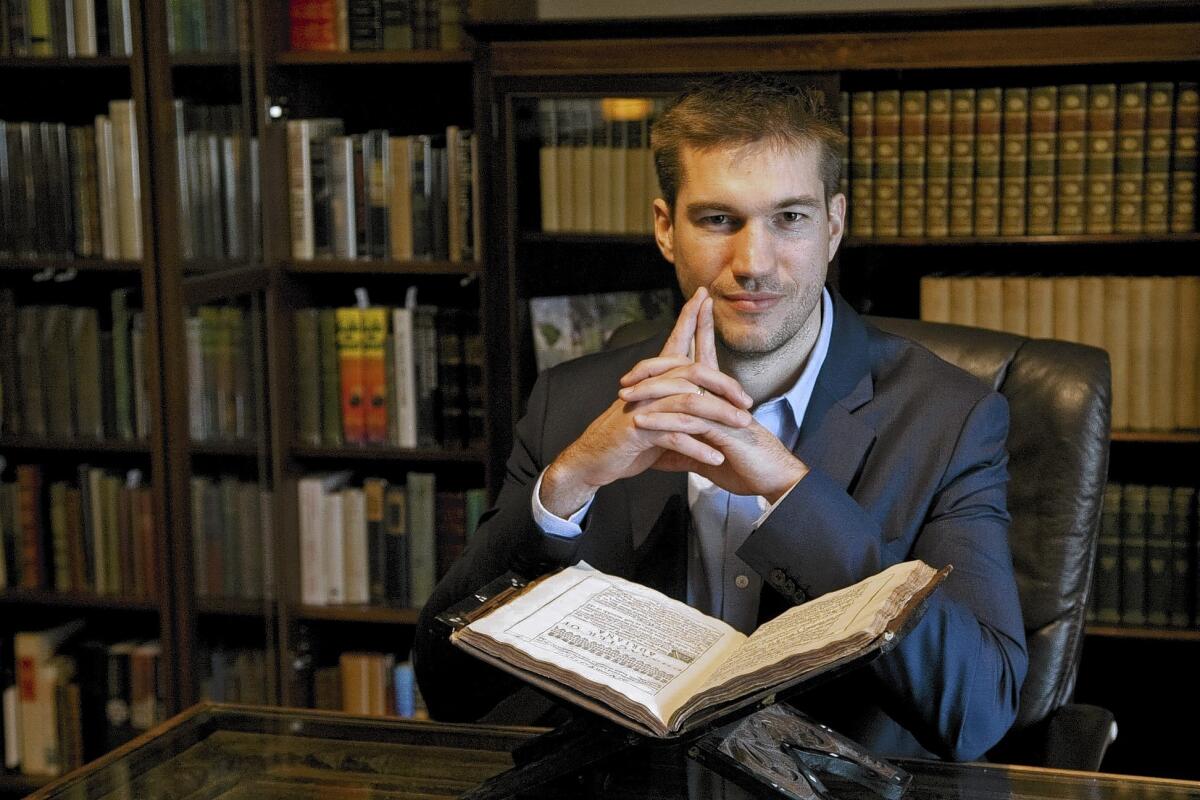Younger book dealers are diving into the antiquarian trade

In the dark economic times of 2009, Dan Whitmore decided to give up being a lawyer in downtown Los Angeles to sell antiquarian books. “People in the firm thought I was nuts,” he says.
Now he runs Whitmore Rare Books from his home in Altadena. At 33, he’s one of the next generation of antiquarian booksellers — young people going against the digital tide to sell old books, the kind printed in ink on paper.
“Right now, we have more younger members than we had 10 years ago,” says John Thomson, president of the Antiquarian Booksellers’ Assn. of America. The organization, which has more than 400 members nationwide, is presenting the 47th California International Antiquarian Book Fair this weekend in Pasadena.
This new generation of antiquarian booksellers has turned to the trade during the ascendancy of e-books. The ephemeral format was popularized after the 2007 debut of Amazon’s Kindle; now e-books make up 25% of trade book sales, a share that’s growing. Print, we’ve been told over and over, is dead: why bother with dusty old books?
Thomson, who has operated Bartleby’s Books in Maryland for 27 years and been in the business for 40, says that young dealers are the only ones who can truly address that question. “When cultural thinking changes, new material becomes relevant in a way it wasn’t before,” he says. “The young trade knows that from within. They’re living it.”
Next-generation antiquarian Heather O’Donnell launched her business, the Brooklyn-based Honey & Wax Booksellers, in 2011. “In the realm of book collecting, e-books have primarily served to highlight what’s particularly interesting about print books,” she says. “Handling a rare book — a book that has a special story behind it or something really unique in its binding, illustrations or just physicality — seems all the more exciting now because so much of the actual experience of reading for people has been moved on screen.”
O’Donnell learned the meticulous trade of antiquarian bookselling at Bauman Rare Books, one of the country’s preeminent dealers. That was essential in earning the trust of clients in a field where a good reputation is essential. Honey & Wax is also informed by O’Donnell’s love of literature — she has a PhD in English — and beautiful books, especially those with unique stories.
The most extraordinary example of this is her complete first edition of Marcel Proust’s “In Search of Lost Time” — actually, “À La Recherche Du Temps Perdu,” since Proust wrote it in French. A complete copy is a rare find, and this one is particularly special because it was inscribed by Proust to fellow writer Marcel Prévost.
“Prévost was a much more famous writer at the time that Proust was writing his masterpiece, and for whom he was constantly being confused,” O’Donnell explains. “Prevost was a thorn in his side, but he warmly inscribed this copy to him, I’m sure in the hopes that Prévost would help him.”
The scarcity of the 13-volume set, along with that back story, puts its price at $65,000. That’s the thing about rare books — value comes from a mysterious alchemy of rarity, condition and desire.
As contemporary antiquarians, O’Donnell and Whitmore sell books directly to private clients, at book fairs like the one in Pasadena this weekend and via online stores. Neither has a brick and mortar shop. And it’s not just the case for newcomers: Many longtime booksellers have taken down their shingles in favor of virtual offices.
While young dealers continue to move into the field, the future of the business depends on buyers. Will people raised on digital media embrace the world of book collecting? That remains to be seen since, as Whitmore says, “It’s a matter of disposable income.”
For her part, O’Donnell, 42, is thinking ahead: “I wanted to try to create an operation that would appeal to younger collectors, both by having things at a lower price point and also by being conversational and approachable and telling the stories of these books in a way that was engaging.”
Though part of that is about building relationships with customers who may look for more valuable books in the future, it’s also about redefining value. Her Proust-to-Prévost book is like a social media connection made 100 years ago, albeit written by hand in the flyleaf of one of our great works of literature.
The cavernous used bookstore presided over by the mythical tweedy gentleman is swiftly disappearing. Cheaper books can be easily bought and sold online, while many older classics can be downloaded free.
“Digital books and the availability of inexpensive used books has changed the business model for lots of used bookshops and the lower end of the market, but the higher end hasn’t been affected,” Whitmore explains. “If someone’s looking to buy a presentation copy of a Hemingway book or Fitzgerald and spend $20,000 or $50,000 on it, that book’s not competing with digital media.”
Whitmore has held his own against digital media while moving forward in the antiquarian world. He’s worked his way up to becoming a member of the ABAA, and will have a booth at the Pasadena fair for the first time this year.
From time to time he runs into his old colleagues from the law firm, he says, who ask him, “You still doing the books?”
“It feels good to be able to say I’m a full-time bookseller and making a living at it,” Whitmore says.
California International Antiquarian Book Fair info
Where: Pasadena Convention Center, 300 E. Green St., Pasadena
When: Fri. 3 p.m.-8 p.m., Sat. 11 a.m.-5 p.m., Sun. 11 a.m.-3 p.m.
Tickets: $25 for a 3-day pass; $15 for a Sat.-Sun. pass
Info: https://www.cabookfair.com
More to Read
Sign up for our Book Club newsletter
Get the latest news, events and more from the Los Angeles Times Book Club, and help us get L.A. reading and talking.
You may occasionally receive promotional content from the Los Angeles Times.





